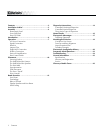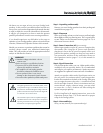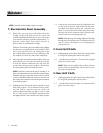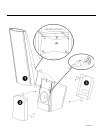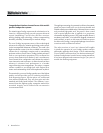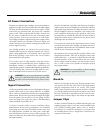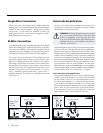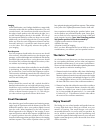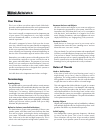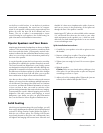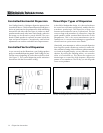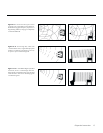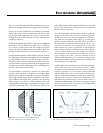
10 Placement
PLACEMENT
By now your speakers should be placed approximately
two to three feet from the front wall, the wall in front of
the listening position, and at least one to two feet from
the side walls. Your sitting distance should be further
than the distance between the speakers themselves. What you
are trying to attain is the impression of good center imaging
and stage width.
There is no exact distance between speakers and listener,
but there is a relationship. In long rooms, naturally, that
relationship changes. The distance between the speakers
will be far less than the distance from you to the speaker
system. However, in a wide room, you will still find that if
the distance from the listener to the speakers becomes
smaller than the distance between the speakers themselves,
the image will no longer focus in the center.
Now that you have positioned your speaker system, spend
some time listening. Wait to make any major changes in
your initial setup for the next few days as the speaker
system itself will change subtly in its sound. Over the first
40 hours of play the actual tonal quality will change slightly
with deeper bass and more spacious highs resulting.
After a few days of listening you can begin to make refinements
and hear the differences of those refinements.
The Wall Behind the Listener
Near-field reflections can also occur from your back wall
(the wall behind the listening position). If your listening
position is close to the back wall, these reflections can
cause problems and confuse the quality of imaging.
Actually it is better for the wall behind you to be soft
than to be bright. If you have a hard back wall and your
listening position is close to it, experiment with devices
that will soften and absorb information (i.e. wall hangings
and possibly even sound absorbing panels).
The Wall Behind the Speakers
The front surface, the wall behind your speakers, should
not be extremely hard or soft. For instance, a pane of glass
will cause reflections, brightness and confused imaging.
Curtains, drapery and objects such as bookshelves can be
placed along the wall to soften a hard surface. A standard
sheet rock or textured wall is generally an adequate
surface if the rest of the room is not too bright and hard.
Sometimes walls can be too soft. If the entire front wall
consists of only heavy drapery, your system can sound too
soft or dull. You may hear dull, muted music with little
ambience. Harder room surfaces will actually help in this case.
The front surface should, optimally, be one long wall
without any doors or openings. If you have openings, the
reflection and bass characteristics from one channel to the
other can be different.
The Side Walls
The same requirements exist for side walls. Additionally, a
good rule of thumb is to have the side walls as far away
from the speaker sides as possible, minimizing near-field
side wall reflections. Sometimes, if the system is bright or
the imaging is not to your liking, and the side walls are
very near, try putting curtains or softening material directly
to the edge of each speaker. An ideal side wall, however,
is no side wall at all.
Experimentation
Toe-in
Now you can begin to experiment. First begin by toeing
your speakers in towards the listening area and then facing
them straight into the room. You will notice that the tonal
balance changes slightly. You will also notice the imaging
changing. Generally it is found that the ideal listening
position is with the speakers slightly toed-in so that you are
listening to the inner third of the curved transducer section.
Experimenting with the toe-in will help in terms of tonal
balance. You will notice that as the speakers are toed-out,
the system becomes slightly brighter than when toed-in.
This design gives you the flexibility to compensate for a
soft or bright room.
Tilting the Speakers Backwards and Forwards
As can be seen from the diagrams in the Room Acoustics
section of this manual, the vertical dispersion is directional
above and below the stator panel itself. In some instances, if
you are sitting close to the floor, slight forward tilting of the
speakers can enhance clarity and precision.
Listening Position



